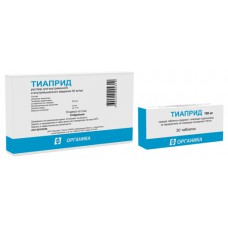Expiration date: 05/2025
Structure and Composition:
Tablets. One tablet contains: tiapride 100 mg
auxiliary substances: milk sugar (lactose), potato starch low molecular weight PVP Medical (povidone), magnesium stearate
in blisters of 10 pieces. in a stack of cardboard 3 packaging or in a dark glass banks to 30 pc. In the paper cartons 1 bank.
Solution for intravenous and intramuscular administration. 1 ml contains tiapride 50 mg
Excipients: sodium chloride, water for injection
in 2 ml ampoules, complete with knife ampulnam in paper cartons of 10 vials or in blisters 5 ampoules in a pack of 2 cardboard packaging.
Description pharmaceutical form:
Tablets: white or white with weak yellowish shade, Valium forms a chamfer.
The solution for intravenous and intramuscular injection: clear, colorless or slightly colored liquid.
Pharmacokinetics:
Bioavailability is 75%. Assignment immediately before meal increases bioavailability by 20% and plasma Cmax - 40%. The absorption in the elderly is slowing down.
After ingestion tiapride 200 mg Cmax in plasma was 1.3 mg / ml and is achieved 1 hour after intramuscular injection of 200 mg (2.5 ug / ml) - 30 min.
The binding to plasma proteins and red blood cells weak. Distribution in the body is rapid (less than 1 hour). It penetrates through the BBB and placental barrier. When pill accumulation does not occur. The animals in the study mentioned in the form of tablets penetration into milk, with the ratio of concentrations in milk and blood of 1: 2 in the application solution for intravenous and intramuscular administration tiapride also penetrates into breast milk (concentration of 50% of plasma).
It is metabolized in the liver. Metabolism tiapride very low - 70% of the dose found in the urine in unchanged form. T1 / 2 of the plasma is 2.9 hours in women and in men 3.6 h. Isolation occurs predominantly in the urine, kidney and Cl reaches 330 ml / min. In chronic renal failure, the degree of reduction excretion correlates with the magnitude of Cl creatinine.
Description of the pharmacological actions:
Antipsychotics (antipsychotic) has a hypnotic, sedative, analgesic effect. Eliminates dyskinesia central origin. It has a pronounced analgesic effect as in the interoceptive and exteroceptive with pain. Antipsychotic effect due to blockade of dopamine D2-receptor and Mesocortical mesolimbic system. Sedative effect due to blockade of adrenergic receptors of the reticular formation of the brain antiemetic action - blockade of dopamine D2-receptor trigger zone of the vomiting center hypothermic action - blockade of dopamine receptors of the hypothalamus.
Indications:
Pills
Adults:
- psychomotor agitation and aggressive state, especially in chronic alcoholism or in old age
- intense chronic pain syndrome.
Adults and children over 6 years:
- Various types of chorea
- Gilles de la Tourette syndrome.
Children over 6 years: conduct disorder with agitation and aggressiveness.
Solution for intravenous or intramuscular administration
- Hyperkinetic and dyskinetic syndrome (including the use of antipsychotic drugs (neuroleptics), Parkinson's disease, vascular origin, tardive dyskinesias)
- acute and chronic chorea
- tic
- senile motor instability
- tremor
- headache (neurogenic origin)
- conduct disorder (alcoholism)
- psychomotor agitation
- behavioral disorders in the elderly
- alcoholic psychosis
- abstinence syndrome (alcoholism, drug addiction)
- chronic pain syndrome (including arthralgia, cramps in the limbs, pain in cancer patients, pain neurotic origin).
Contraindications:
Common for both formulations:
- Hypersensitivity to tiaprid or other ingredients
- diagnosed or suspected pheochromocytoma
- pregnancy (I trimester)
- lactation
- Children's age (for tablets - up to 6 years for a solution for intravenous and intramuscular injection - up to 7 years)
- hypertensive crisis
- severe renal and / or hepatic impairment.
For tablets (optional):
- prolactin dependent diagnosed or suspected tumors, such as pituitary gland prolactinoma and breast cancer
- combination with sultopride
- combination with dopaminergic agonists (amantadine, apomorphine, bromocriptine, cabergoline, entacapone, lisuride, pergolide, piribedil, pramipexole, quinagolide, ropinirole), except in patients with Parkinson's disease
- combination with drugs that can cause heart rhythm disturbance: antiarrhythmics Ia class (quinidine, gidrohinidin, disopyramide) and class III (amiodarone, sotalol, dofetilide, Ibutilide), some antipsychotics (thioridazine, chlorpromazine, Levomepromazine, trifluoperazine, tsiamemazin, amisulpirid, sulpiride, pimozide, haloperidol, droperidol), as well as with the following medications: levodopa, bepridil, cisapride, difemanil, erythromycin, mizolastine, vincamine to / in the introduction, sparfloxacin, moxifloxacin (see "Interactions")..
Carefully:
Common for both formulations:
- chronic renal failure. In the application it is necessary to reduce the dose and increase surveillance (see. "Dosage and administration")
- epilepsy, due to the possibility of lowering the seizure threshold
- cardiovascular diseases in the decompensation stage
- Parkinson's disease
- elderly age.
For tablets (optional):
- the combined use of drugs containing alcohol
- bradycardia (less 55 beats / min), hypokalaemia, congenital QT prolongation, and in the combined use of drugs that can cause severe bradycardia (less than 55 beats / min), hypokalaemia, decreased cardiac conduction, or prolongation of the interval QT.
Application of pregnancy and breastfeeding:
The drug is contraindicated in the I trimester of pregnancy and lactation.
Regarding the effect of antipsychotic drugs used during pregnancy, fetal brain data are not available (preferably not be used during pregnancy tiaprid).
However, if the drug is still applied during pregnancy, it is advisable to limit as much as possible the dose and duration of treatment.
In long-term treatment and / or the use of high doses and / or in later stages of pregnancy justified newborn neurological control functions.
It is not known whether the breast milk tiaprid penetrate, so it is recommended to stop breast-feeding at the time of taking the drug.
Side effect:
Pill
Asthenia, fatigue, somnolence, insomnia, agitation, agitation, apathetic state, dizziness, headache, increased blood pressure, Parkinson's disease - tremor, bradykinesia, hypersalivation. Much less frequently: early dyskinesia and dystonia (spasmodic torticollis, oculogyric crises, lockjaw), akathisia. These symptoms are usually reversible upon discontinuation of the drug or the appointment of anticholinergic antiparkinsonian agents. Tardive dyskinesia (involuntary stereotypic movements of the tongue, face and limbs) occurring with prolonged use (anticholinergic antiparkinsonian agents appointed as correctors, may worsen the patient's condition). Hyperprolactinemia and mating with her disorder (less than 0.2%): amenorrhea, galactorrhea, breast swelling, chest pain, impotence or breaking weight gain ejaculation, lengthening the interval QT, atrial arrhythmias, postural hypotension, neuroleptic malignant syndrome.
For solution for intravenous and intramuscular injection
Drowsiness, fatigue, decreased muscle tone, agitation, extrapyramidal symptoms, neuroleptic malignant syndrome, early dyskinesia (spasmodic torticollis, trismus, oculomotor disturbances) and tardive dyskinesias phenomena hyperstimulation (increased anxiety or exacerbation of hallucinatory-delusional symptoms in patients with schizophrenia), allergic skin reactions, orthostatic hypotension, weight gain, hyperprolactinemia, reduced potency, gynaecomastia, amenorrhea, galactorrhea, frigidity, hyperthermia.
Drug Interactions:
Pill
When used in conjunction with antiarrhythmic drugs, and drugs that cause bradycardia, hypokalemia, and may increase the risk of ventricular arrhythmias, and atrial fibrillation. Joint reception with antihypertensive drugs increases the risk of postural hypertension.
There is a mutual antagonism action of levodopa and neuroleptics. In patients with Parkinson's disease, it is recommended to use the minimum effective dose of levodopa and tiapride.
Dopaminergic agonists may cause or exacerbate psychotic disorders. If you need neuroleptic treatment to a patient suffering from Parkinson's disease receiving dopaminergic drug, the dose should be gradually reduce the latter to cancel (abrupt withdrawal may lead to the development of neuroleptic malignant syndrome).
Drugs that suppress the central nervous system function when combined with the admission tiaprid, promote inhibitory action.
Alcohol increases the sedative effect of neuroleptics.
For solution for intravenous and intramuscular injection
It enhances the effect of drugs which depress the central nervous system (narcotic analgesics, barbiturates, antihistamines drugs, benzodiazepines), as well as ACE inhibitors and other antihypertensive drugs. Incompatible with levodopa and ethanol.
Dosage and administration:
Pills
Inside, only for adults and children over 6 years. Always choose the minimum effective dose. If the patient's condition allows, treatment should be started at a low dose and gradually increasing it.
Psychomotor agitation and aggressive state, especially in chronic alcoholism or in old age: for adults - 200-300 mg / day treatment course of 1-2 months in old age - 50 mg 2 times a day. The dose can be gradually increased by 50-100 mg every 2-3 days to a maximum daily dose of 300 mg.
Chorea, Gilles de la Tourette's syndrome: adults - 300-800 mg / day. Treatment should be initiated at a dose of 25 mg / day, then slowly increase it until the minimum effective dose.
Patients with impaired renal function if creatinine Cl <20 ml / min, the daily dose should be set, depending on the severity of renal failure. Apply half the dose when creatinine Cl 11-20 ml / min and 1/4 dose as Cl creatinine 10 ml / min.
Intense chronic pain syndrome: Children older than 6 years - 3-6 mg / kg / day. The usual adult dose is 200-400 mg / day.
Conduct disorder with agitation and aggression in children over the age of 6 years: the dose is 100-150 mg / day.
Solution for intravenous or intramuscular administration
B / or in V / m.
Nekupiruyuschiesya pain: -200-400 mg / day.
When delirious (predelirioznom) state: every 4-6 hours at a daily dose of 400-1200 mg (maximum 1800 mg).
When creatinine Cl <20 ml / min, the daily dose reduced by 2 times when creatinine Cl <10 ml / min - 4 times.
Children aged 7 years and older - 100-150 mg / day. You can increase the dosage to a maximum of 300 mg / day.
Overdose:
Pill
Symptoms: excessive sedation, drowsiness, depression of consciousness up to coma, hypotension, extrapyramidal symptoms.
Treatment: removal of the drug, gastric lavage, symptomatic and detoxification therapy, monitoring of vital body functions (especially cardiac - risk of QT interval prolongation) up to the complete disappearance of symptoms of intoxication. In case of severe extrapyramidal symptoms - anticholinergic treatment. Since tiaprid weakly dialyzed to remove the substance is not recommended dialysis. Antidote tiapride unknown.
For solution for intravenous and intramuscular injection
Symptoms: marked sedation, extrapyramidal disorders.
Treatment: removal of the drug, the appointment of anticholinergics.
Special instructions:
Pill
Neuroleptic malignant syndrome: is characterized by paleness, hyperthermia, muscle rigidity, dysfunction of the peripheral nervous system, impaired consciousness. Signs of dysfunction of the peripheral nervous system, such as sweating and blood pressure lability may precede the onset of hyperthermia and, therefore, represent the early warning signals. Certain risk factors, such as dehydration or organic brain damage, despite the fact that such action may be due to the idiosyncrasy of neuroleptics apparently are contributory.
QT prolongation: tiaprid causes a dose-dependent prolongation of the interval QT. It is known that this effect increases the risk of serious ventricular arrhythmias, it is enhanced by bradycardia, hypokalemia during, and in the case of congenital or acquired long QT interval (combination with drugs that prolong the interval QTc). Hypokalemia must be corrected before the start of the drug, in addition, should ensure control of the clinical picture, ECG and electrolyte balance.
When extrapyramidal syndrome induced by neuroleptics, anticholinergics should be used instead of using dopaminergic agonists.
In the period of treatment should refrain from activities potentially hazardous activities that require high concentration and psychomotor speed reactions.
For solution for intravenous and intramuscular injection
In the period of treatment should refrain from receiving ethanol and use caution when driving and occupation of other potentially hazardous activities that require high concentration and psychomotor speed reactions.




